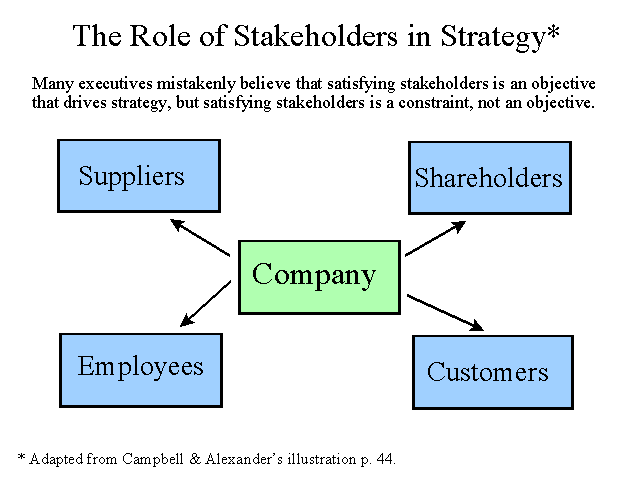
Summary by Justin Gerber
Master of Accountancy Program
University of South Florida, Summer 2003
Balanced Scorecard Main Page |
Strategy Related Main Page
The purpose of this article is to explain what's wrong with current ways of developing strategy and how to progress toward a winning strategy. What is wrong with strategy or the development of strategy?
First, objectives are often misused. Managers do not distinguish the difference between purpose and constraints. Purpose is what an organization exists to do or accomplish. Constraints are what an organization must do to survive. This failure just leads to confusion, which leads to miss-directed strategies.
Second, organizations cannot decide where to start. Should managers develop strategies and then set objectives? Or should they set objectives and then develop strategies to attain the objectives? This causes paralysis within the organization.
Third, planning processes are expected to develop new improved strategies, while good strategy is developed through insight into how to create value. Planning processes and meetings often create worthless plans that cannot be implemented. The answer to a good strategy is understanding two points: having a well-articulated, stable purpose, and knowing how to discover, understand, document, and exploit insights about how to create more value than other companies do.
Many annual reports claim that their company’s objective is to “Provide a superior return to our shareholders.” These statements do not help develop a good strategy, but only restate the “rules of the economic game that companies play.” The real goal of companies’ is to gain and maintain a competitive advantage. The stakeholder model below helps explain the links between stakeholder value and competitive advantage.

Companies require loyalty from all stakeholders in order to function. Companies cannot sell products without customers, purchase supplies without suppliers, etc. Companies must realize that these stakeholders are infinitely greedy. They want as much out of the company as they can get. This brings about the need to gain a competitive advantage over competitors. Stakeholder value, therefore, is not an objective, but an economic constraint. If the company fails to maintain an advantage over the competition, it will lose its shareholders. Since competitive advantage is a constraint rather than an objective, companies must look elsewhere for starting points for development of strategy. Companies need to focus on objectives that answer why they exist. While making money for shareholders could be a purpose, it provides little guidance for strategy. Therefore, the purpose must be more detailed and focused.
Campbell and Alexander explain that the fundamental building block of strategy consists of insights into value creation. These insights are understandings about production and needs of stakeholders that allow discovery of superior ways to create value. Insights could deal with new ways of doing things in the company or relationships with suppliers, customers, etc. Another example would be the recognition of a new customer service. Insights usually come from floor managers. The authors point out that although floor managers are not the greatest strategists, most insights important for strategy formation are in the minds of floor managers and not top management.
The development of a good strategy is a slippery path. The authors suggest that developing a strategy should begin with an identification of “firm ground.” Purpose is one of the firm spots on the path. The more detailed the purpose the more firm the ground for strategy development. The best purposes give long-term direction. The second piece of firm ground is insights. Insights give meaning to tactics, that allow objectives to be set with accuracy and strategies to be accomplished. How should companies try to develop insights? There are three camps or types of strategists:
The Operating Camp - value comes from processes such as reengineering, time-based competition, benchmarking, total quality management, empowerment and related tools,
The Future Gazing Camp - choosing critical factors to focus on and designing appropriate capabilities using techniques such as scenario analysis, the S-curve, technology maps and chaos theory,
The Behavior & Culture Camp - including two groups, the data-free-plan group and the organizational learning group.
An explanation of all these concepts is beyond the scope of this summary, but the authors provide some interesting comments related to developing insights applicable to strategy development and state that there is no best way to develop insights.
In conclusion, strategy should not be confused with struggling forward in some random direction. Strategy is the combination of defining purpose and discovering insights. Trying to develop strategy without insights is dangerous.
______________________________________________
Related summaries:
Christensen, C. M. 1997. Making strategy: Learning by doing. Harvard Business Review (November-December): 141-142, 144, 146, 148, 150-154, 156. (Summary).
Fonvielle, W. and L. P. Carr. 2001. Gaining strategic alignment: Making scorecards work. Management Accounting Quarterly (Fall): 4-14. (Summary).
Gosselin, M. 1997. The effect of strategy and organizational structure on the adoption and implementation of activity-based costing. Accounting, Organizations and Society 22(2): 105-122. (Summary).
Iansiti, M. and R. Levien. 2004. Strategy as ecology. Harvard Business Review (March): 68-78. (Summary).
Kim, W. C. and R. Mauborgne. 1997. Value innovation: The strategic logic of high growth. Harvard Business Review (January-February): 103-112. (Summary).
Kim, W. C. and R. Mauborgne. 1999. Creating new market space: A systematic approach to value innovation can help companies break free from the competitive pack. Harvard Business Review (January-February): 83-93. (Summary).
Langfield-Smith, K. 1997. Management control systems and strategy: A critical review. Accounting, Organizations and Society 22(2): 207-232. (Summary).
Luehrman, T. A. 1998. Strategy as a portfolio of real options. Harvard Business Review (September-October): 89-99. (Summary).
O'Clock, P. and K. Devine. 2003. The role of strategy and culture in the performance evaluation of international strategic business units. Management Accounting Quarterly (Winter): 18-26. (Summary).
Porter, M. E. 1996. What is a strategy? Harvard Business Review (November-December): 61-78. (Summary).
Reeves, M., C. Love and P. Tillmanns. 2012. Your strategy needs a strategy. Harvard Business Review (September): 76-83. (Note).